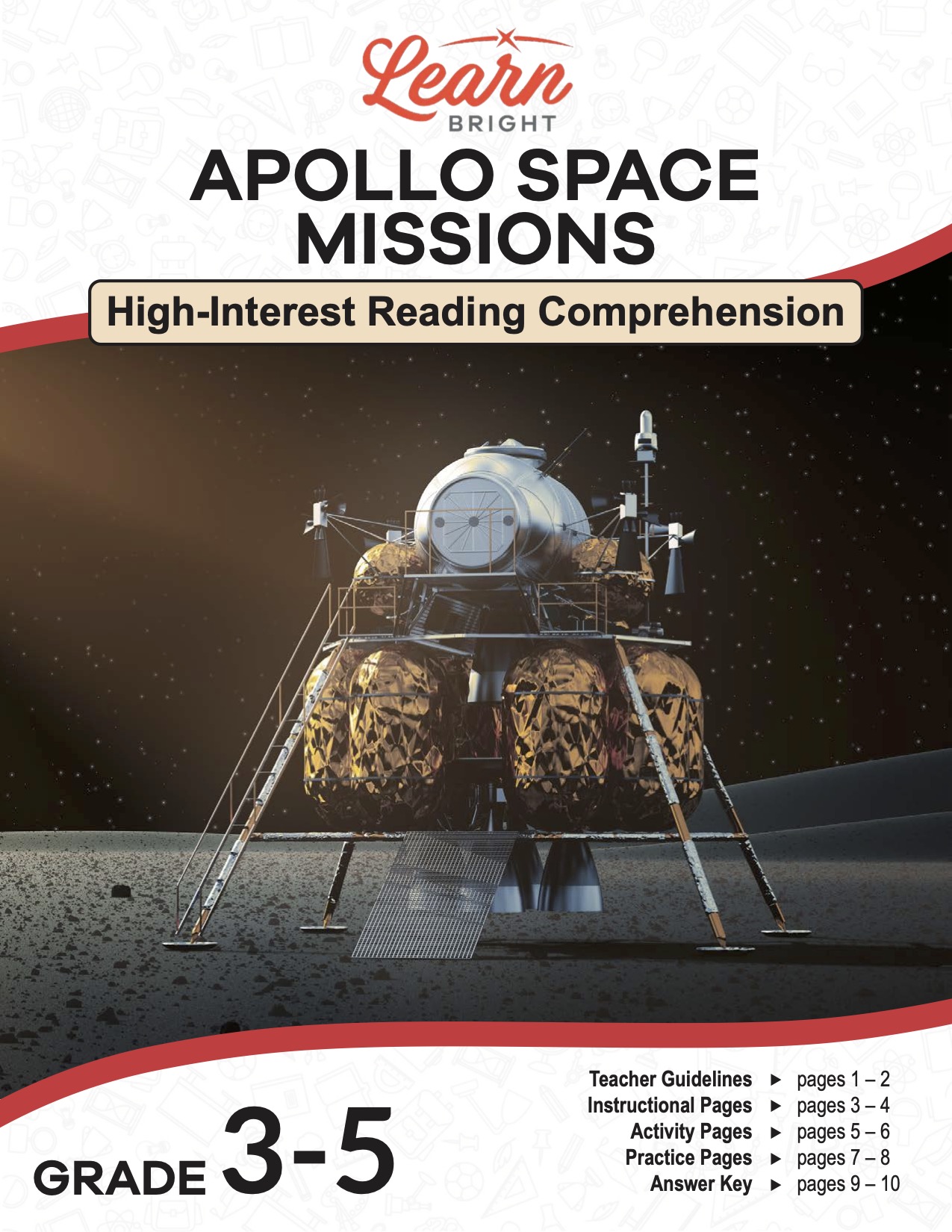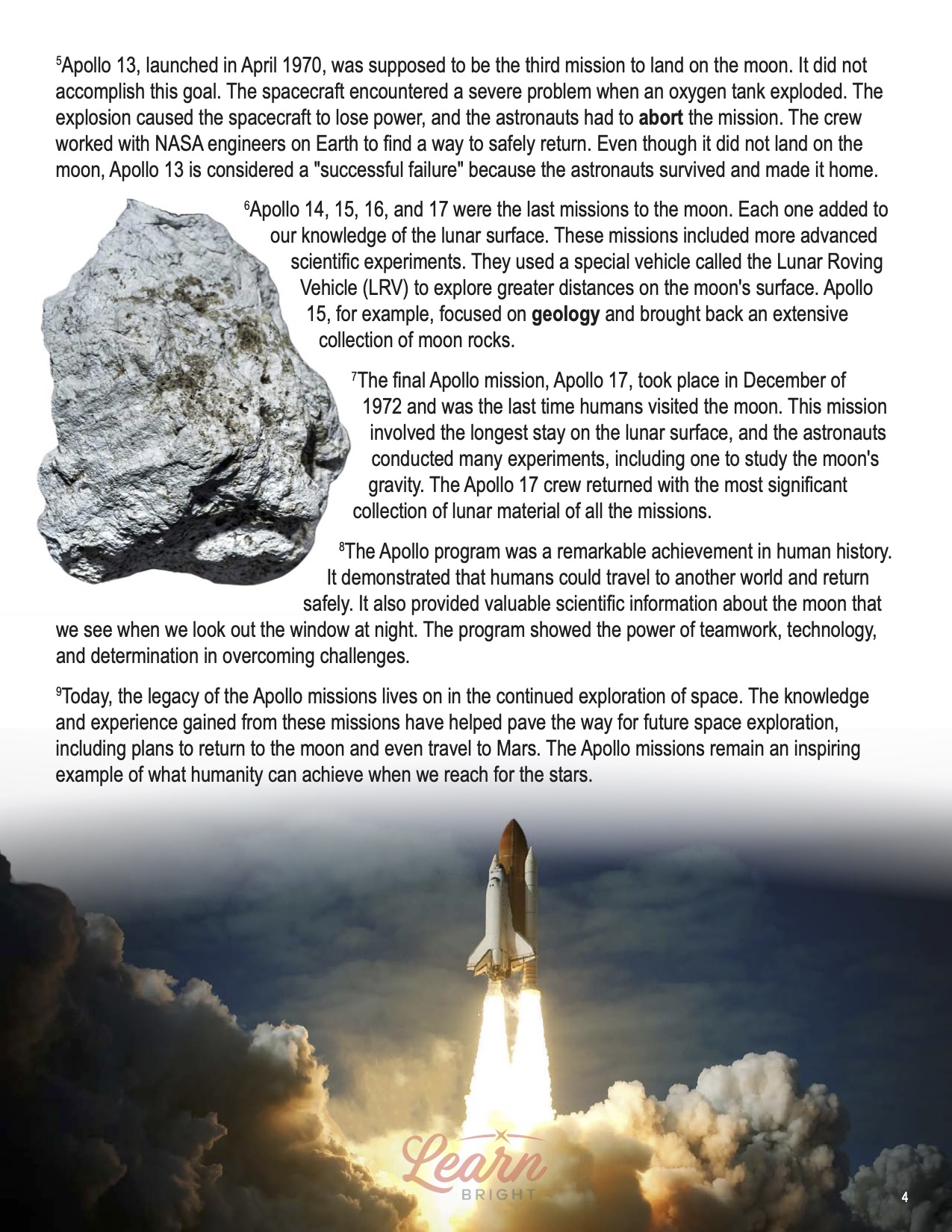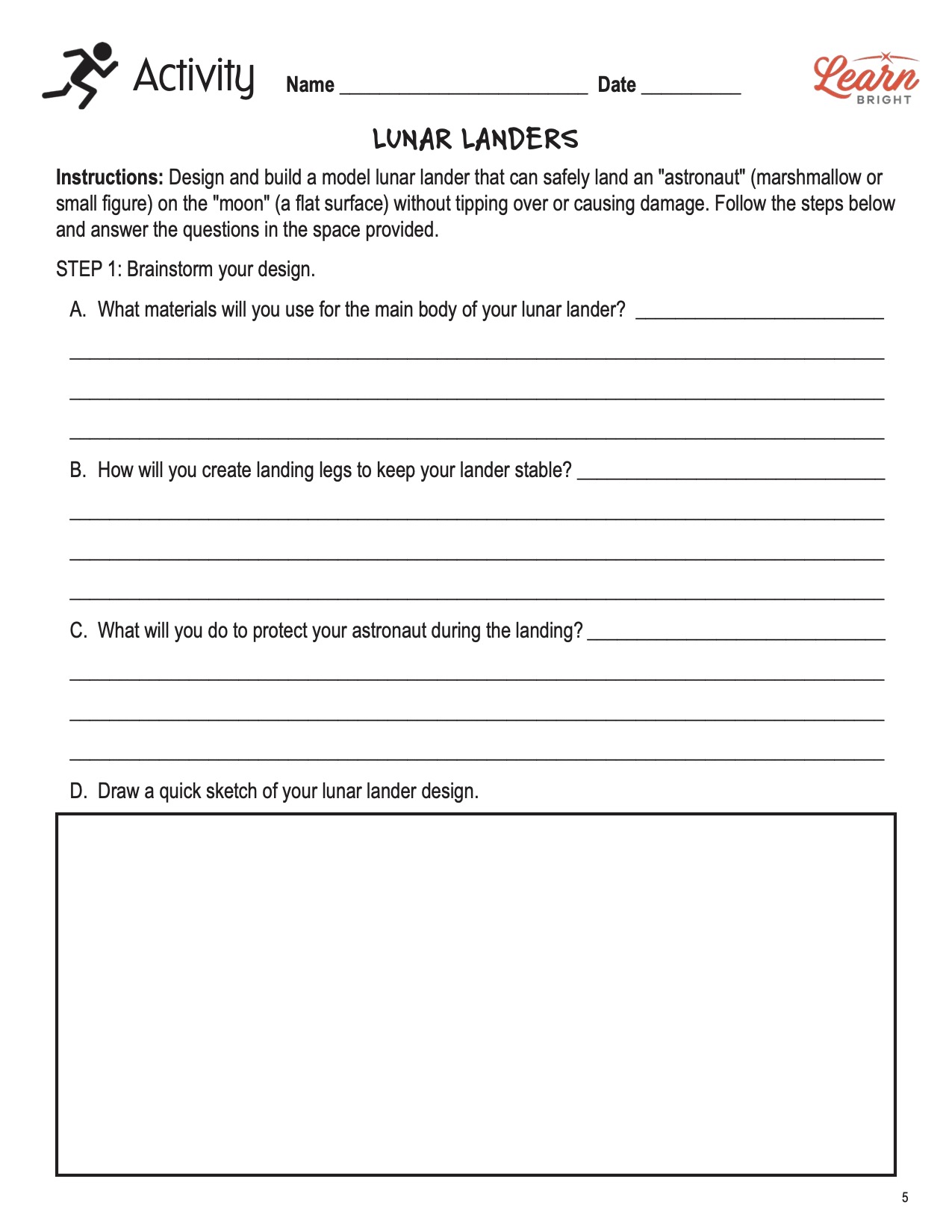Description
Apollo Space Missions lesson plan includes
Lesson Objectives and Overview: Apollo Space Missions is a high-interest reading comprehension lesson plan. As such, students will determine the central idea or theme of the article and understand more about the Apollo space missions. This lesson is for students in 3rd grade, 4th grade, and 5th grade.
Classroom Procedure
Every lesson plan provides you with a classroom procedure page that outlines a step-by-step guide to follow. You do not have to follow the guide exactly. The guide helps you organize the lesson and details when to hand out worksheets. It also lists information in the yellow box that you might find useful. You will find the lesson objectives, state standards, and number of class sessions the lesson should take to complete in this area. In addition, it describes the supplies you will need as well as what and how you need to prepare beforehand. Some of the supplies you need for the activity include marshmallows, paper cups, tape, scissors, aluminum foil, cotton balls, and markers or stickers for decoration.
Teacher Notes
The teacher notes page provides an extra paragraph of information to help guide the lesson and remind you what to focus on. It explains that you can teach this lesson in a whole-class setting or as an independent, small-group activity. The blank lines on this page are available for you to write out thoughts and ideas you have as you prepare the lesson.
APOLLO SPACE MISSIONS LESSON PLAN CONTENT PAGES
What Were the Apollo Space Missions?
The Apollo Space Missions lesson plan contains two content pages. The Apollo space missions were a series of missions conducted by NASA, the United States space agency, to land humans on the moon and bring them safely back to Earth. These missions occurred during the 1960s and early 1970s and were part of the space race between the US and the Soviet Union. The Apollo missions are famous for being the first, and so far only, missions to send humans to another celestial body and land on the moon!
The first successful mission in the Apollo program was Apollo 7, launched in October 1968. This mission did not go to the moon, but it was an essential step in testing the spacecraft that would later be used for lunar landings. The crew orbited Earth, tested the spacecraft’s systems, and practiced maneuvers necessary for future lunar missions.
Famous Missions
The most famous Apollo mission is Apollo 11, which made history on July 20, 1969, when astronauts Neil Armstrong and Edwin “Buzz” Aldrin became the first humans to walk on the moon. Armstrong’s first words as he stepped onto the lunar surface were, “That’s one small step for man, one giant leap for mankind.” The astronauts collected samples of moon rocks and conducted experiments before returning safely to Earth.
Apollo 12 was the next mission to land on the moon in November 1969. This mission also included scientific experiments and the collection of moon rocks. The crew of Apollo 12 landed near a robotic spacecraft called Surveyor 3. Surveyor 3 had previously landed on the moon and allowed the astronauts to study it and bring parts of it back to Earth.
Apollo 13, launched in April 1970, was supposed to be the third mission to land on the moon. It did not accomplish this goal. The spacecraft encountered a severe problem when an oxygen tank exploded. The explosion caused the spacecraft to lose power, and the astronauts had to abort the mission. The crew worked with NASA engineers on Earth to find a way to safely return. Even though it did not land on the moon, Apollo 13 is considered a “successful failure” because the astronauts survived and made it home.
The last missions to the moon were Apollo 14, 15, 16, and 17. Each one added to our knowledge of the lunar surface. These missions included more advanced scientific experiments. They used a special vehicle called the Lunar Roving Vehicle (LRV) to explore greater distances on the moon’s surface. Apollo 15, for example, focused on geology and brought back an extensive collection of moon rocks.
Final Mission
The final Apollo mission, Apollo 17, took place in December of 1972 and was the last time humans visited the moon. This mission involved the longest stay on the lunar surface, and the astronauts conducted many experiments, including one to study the moon’s gravity. The Apollo 17 crew returned with the most significant collection of lunar material of all the missions.
The Apollo program was a remarkable achievement in human history. It demonstrated that humans could travel to another world and return safely. It also provided valuable scientific information about the moon that we see when we look out the window at night. The program showed the power of teamwork, technology, and determination in overcoming challenges.
Today, the legacy of the Apollo missions lives on in the continued exploration of space. The knowledge and experience gained from these missions have helped pave the way for future space exploration, including plans to return to the moon and even travel to Mars. The Apollo missions remain an inspiring example of what humanity can achieve when we reach for the stars.
APOLLO SPACE MISSIONS LESSON PLAN WORKSHEETS
The Apollo Space Missions lesson plan includes two worksheets: an activity worksheet and a practice worksheet. Each one will help students solidify their grasp of the material they learned throughout the lesson. You can refer to the classroom procedure guidelines to know when to hand out each worksheet.
LUNAR LANDERS ACTIVITY WORKSHEET
For this activity, students will design and build models of a lunar lander that can safely land an “astronaut” (marshmallow or small figure) on the “moon” (a flat surface). The lander cannot tip over or cause any damage. The worksheet provides steps for students to follow and a box in which they can sketch their design.
APOLLO SPACE MISSIONS REVIEW PRACTICE WORKSHEET
The practice worksheet lists 11 questions based on the content. These questions all relate to the content pages, so students will need to refer to them often for the answers. In addition, each question provides which reading tool the question corresponds to, such as text feature, vocabulary, or comprehension.
Worksheet Answer Keys
At the end of the lesson plan document is an answer key for the practice worksheet. The correct answers are all in red to make it easier for you to compare them with students’ responses. If you choose to administer the lesson pages to your students via PDF, you will need to save a new file that omits these pages. Otherwise, you can simply print out the applicable pages and keep these as reference for yourself when grading assignments.










